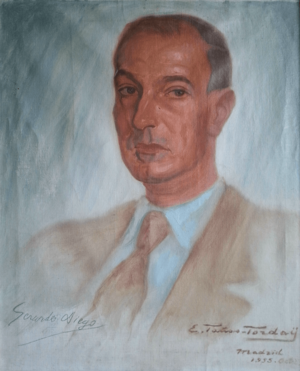Gerardo Diego facts for kids
Quick facts for kids
The Most Excellent
Gerardo Diego
|
|
|---|---|

Portrait by Emeric Tauss Torday
|
|
| Born |
Gerardo Diego Cendoya
3 October 1896 Santander, Spain
|
| Died | 8 July 1987 (aged 90) Madrid, Spain
|
| Seat I of the Real Academia Española | |
| In office 15 February 1948 – 8 July 1987 |
|
| Preceded by | Blas Cabrera |
| Succeeded by | Claudio Rodríguez |
Gerardo Diego Cendoya (born October 3, 1896 – died July 8, 1987) was an important Spanish poet. He was a member of the Generation of '27, a famous group of writers.
Gerardo Diego taught language and literature in schools in different Spanish cities. These included Soria, Gijón, Santander, and Madrid. He also wrote reviews about books and music for various newspapers.
Life and Early Works
Gerardo Diego was born in Santander, a city in Spain. He studied Philosophy and Humanities at the University of Deusto. Later, he continued his studies at the universities of Salamanca and Madrid, where he earned his doctorate degree.
In 1919, he helped start a new art movement called Ultraísmo with another writer, Juan Larrea. This movement focused on new ways of writing poetry. He began his own poetry journey with his book El romancero de la novia in 1920.
Poetry and Recognition
Gerardo Diego became very interested in the Creacionismo movement after learning about the Chilean poet Vicente Huidobro. Creacionismo meant that poets should create new worlds with their words, not just describe them.
Diego's many poems often mixed different styles. He used both new, experimental ideas (Vanguardism) and older, more traditional poetry forms. In 1925, he won the National Prize for Literature for his book Versos humanos.
In 1927, he started a magazine called Carmen y Lola. This magazine was known for its modern and experimental style. He also published a book about Spanish poetry in 1932, called Poesía española contemporánea.
Gerardo Diego was chosen to be a member of the Real Academia Española. This is a very important group that looks after the Spanish language. He took his seat on February 15, 1948. His great work as a writer was honored with the Cervantes Prize in 1979. This is one of the most important awards for Spanish-language writers.
He passed away in Madrid in 1987, when he was 90 years old.
See also
 In Spanish: Gerardo Diego para niños
In Spanish: Gerardo Diego para niños- Café Gijón (Madrid)

